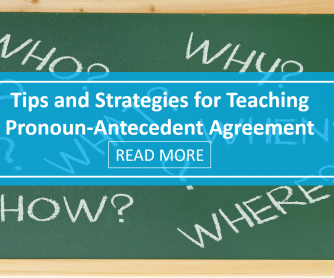
A pronoun must agree with its antecedent in person, gender, and number. Sounds easy, right? Unfortunately, it's not always such an easy concept for students to grasp, especially in a world where "they" and "their" have gained acceptance as singular pronouns to avoid gender issues. Howver, it is possible for students to master agreement. It just takes a lot of practice and plenty of examples to help them learn to recognize when it's done correctly and fix it when it's not.
Define Antecedent
Antecedent is a big word that probably doesn't make sense to learners. Take some time to point out the key part of the word - "ante." Once students recognize that "ante" means "before," they'll start to recognize that an antecedent is the noun that comes before the pronoun (and to which the pronoun refers). As you start to teach pronoun-antecedent agreement, take some time to identify the pronouns and antecedents in sentences. Try to throw in some tricky sentences where the antecendent isn't close to the pronoun to get students to think more about what the sentence actually says.
Label with Pronouns
To help students understand pronoun-antecedent agreement, it may help to have them label various antecedents with appropriate pronouns. You can do this by physically labeling people and objects around the classroom with pronouns. For example, you could have three students stand together and label them with "them" or "us" or you could label a stapler with "it." Then you can give students a copy of a paragraph that is written without pronouns and have them go back and add in pronouns to replace some of the nouns.
Fill in the Blank
Once learners recognize which pronouns go with which antecedents, you can ease them into using pronouns correctly by having them insert correct pronouns into sentences where they have been removed. For example, you may write the sentences "The dog llicked ______ paw" on the board and have students come up and fill in the blank. You can do this via PowerPoint where the pronoun automatically appears after giving students time to guess, as a game where students have index cards with pronouns on them and must race to add them to the board, or even as a multiple choice worksheet or quiz where students choose the letter of the correct pronoun.
Confusing Pronoun Usage
Some aspects of pronoun-antecedent agreement can trip students up. Some tips for helping students understand unique pronouns are:
- Teach students to add "one" in their head to words like "each," "either," or "neither" to help them remember they are singular.
- Encourage students to focus on the meaning of the sentence. For example, the pronoun "some" can be either singular or plural depending on what it is describing.
- Add in words such as "members" to a collective noun such as "team" to help ensure proper agreement.
Of course, some pronouns will still be difficult for students because they don't follow a standard rule. For example, when two nouns are joined by "either...or" or "neither...nor," the pronoun depeends on the closest antecedent. So if they write, "Either Chris or the boys will bring their favorite dishes to dinner" or "Either the boys or Chris will bring his favorite dish to dinner," it's correct.
Rewriting Sentences to Avoid Confusion (and Frustration)
It's helpful to teach learners how to rewrite sentences to avoid issues with pronoun use, especially if they have to write "his or her" or are not sure what the pronoun should be. For example, the sentence "Each contestant must return his or her application packet" could become "All entrants must return their application packets" or "Each contestant must return an application packet."
When rewriting sentences, students should also watch out for vague or unclear antecedents. For example, "In Ohio, they have many farmers." Who is they referring to? Or in the sentence "Catie told Jenny she was pretty" which one is pretty? The first sentence could be come "Ohio has many farmers" and the second could say, "Catie said to Jenny, 'You are pretty.'"
Correcting Errors
To help students truly grasp pronoun-antecedent agreement, it is helpful to have them look for errors in sentences and to correct thiose errors when they find them. Provide a mix of sentences so students can also see pronouns used correctly. You can give a traditional quiz or play a game where students compete in teams to determine if there is an error in the sentence and be the first to identify that the sentence is correct or fix the error that exists.
Once students haae begun to master the rules of pronoun-antecedent agreement, you can have them go back to their own writing and label all of the pronouns and antecedents to see if they have made any errors.
P.S. If you enjoyed this article, please help spread it by clicking one of those sharing buttons below. And if you are interested in more, you should follow our Facebook page where we share more about creative, non-boring ways to teach English.








